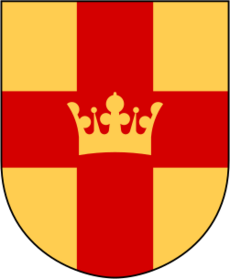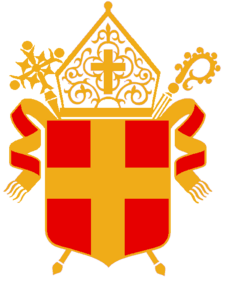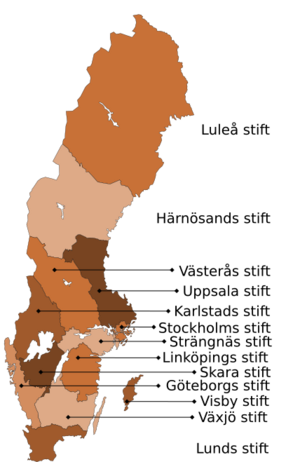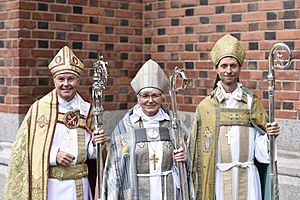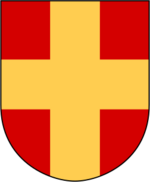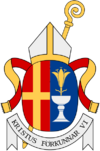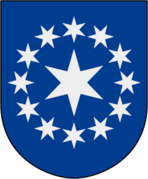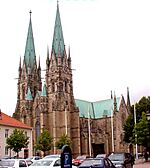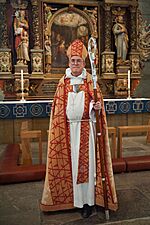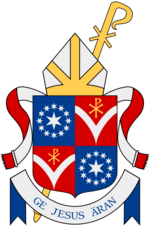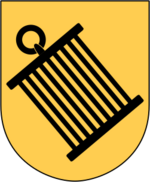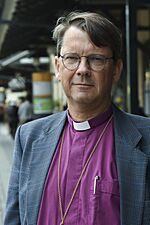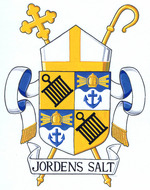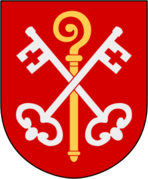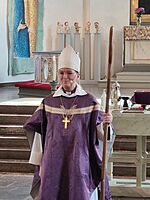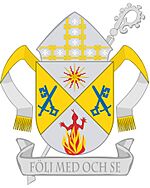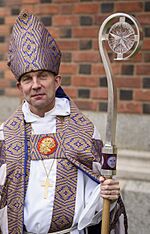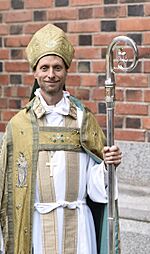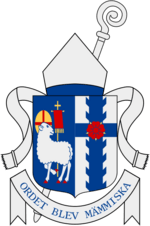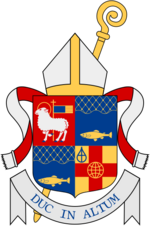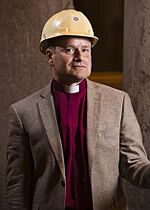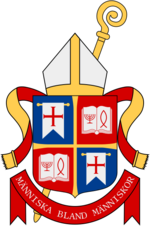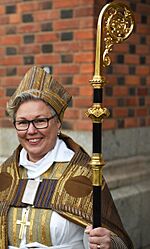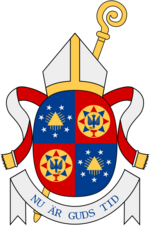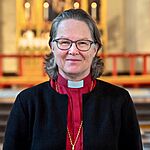Church of Sweden facts for kids
Quick facts for kids Church of Sweden |
|
|---|---|
| Svenska kyrkan | |
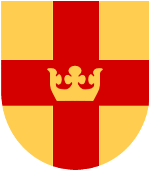
Arms of the Church of Sweden with its centred crown, representing both the victory of Christ over death and the crown of Erik the Holy, Patron Saint of Sweden.
|
|
| Type | National church |
| Classification | Protestant |
| Orientation | Lutheran |
| Scripture | Christian Bible |
| Theology | High church Lutheranism |
| Polity | Episcopal |
| Governance | General Synod |
| Primate | Martin Modéus |
| Associations |
|
| Full Communion |
|
| Region | Sweden |
| Headquarters | Uppsala, Sweden |
| Founder |
|
| Origin | 1014, establishment of the first Swedish diocese, the Diocese of Skara 1164, establishment of the Archdiocese of Uppsala 1536, separation from Rome through the abolition of Canon Law |
| Separated from | Roman Catholic Church (1536) |
| Separations | Evangelical Lutheran Church of Finland (1809) The Mission Province (2003) |
| Congregations | 1 288 in Sweden, 31 abroad (2023) |
| Members | 5 426 053 2024 (51,4 of the total population) |
| Logo | |
The Church of Sweden (Swedish: Svenska kyrkan) is a large Christian church in Sweden. It is a type of Protestant church called Lutheran. It used to be the official state church of Sweden. Its main office is in Uppsala. With about 5.4 million members at the end of 2024, it is the biggest Christian group in Sweden.
The Church of Sweden is part of the Porvoo Communion, a group of churches that share similar beliefs. It follows the teachings of Lutheranism. The church is organized into thirteen areas called dioceses, which are then divided into smaller areas called parishes. The main leader of the Church of Sweden is the Archbishop of Uppsala.
This church is known for keeping many old traditions, like having priests, special clothes for services (vestments), and the Mass. It also believes it has a direct link to the early Christian church through its bishops, a tradition called apostolic succession. The Church of Sweden sees its beliefs as part of the wider Christian faith that has been passed down through history.
About 51.4% of Sweden's population were members of the Church of Sweden at the end of 2024. Until the year 2000, it was the official state church. Before 1996, all babies born in Sweden automatically became members unless their parents chose otherwise. Today, only about 2% of its members attend church services regularly.
Contents
What the Church of Sweden Believes
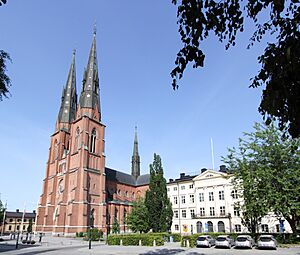
King Gustav Vasa started the Church of Sweden in 1536. This action separated the church in Sweden from the Roman Catholic Church. In 1571, the Swedish Church Ordinance became the first set of rules for the Swedish church after the Reformation.
The Church of Sweden officially became Lutheran at a meeting in Uppsala in 1593. At this meeting, they decided to follow the Augsburg Confession, which is a key statement of Lutheran beliefs. They also kept three important early Christian statements of faith: the Apostolic, the Athanasian, and the Nicene Creeds.
Over time, especially in the 19th and 20th centuries, the church approved other teachings. Many of these were about working together with other Christian churches. For example, they developed a new Catechism (a book of religious instructions) in 1878. They also joined groups like the World Council of Churches (WCC) and the Lutheran World Federation (LWF).
Even though there are official Lutheran texts, local churches often mix Lutheran traditions with ideas from other Christian groups. These can include different styles of worship or spiritual movements.
The Church of Sweden has also focused on human rights. In 1960, women began to be ordained as priests. In 1982, a rule that allowed clergy to refuse to work with female colleagues was removed.
In 2000, the Church of Sweden stopped being the official state church. However, it still has strong connections with communities, especially for important life events. Many babies are baptized, and many teenagers (about 40% of 14-year-olds) go through confirmation, even if their families are not formal church members.
A Look at Church History
Early Christian Times
| Year | Population | Church members | Percentage | % change (avg.) |
|---|---|---|---|---|
| 1972 | 8,146,000 | 7,754,784 | 95.2% | |
| 1975 | 8,208,000 | 7,770,881 | 94.7% | 0.2% |
| 1980 | 8,278,000 | 7,690,636 | 92.9% | 0.3% |
| 1985 | 8,358,000 | 7,629,763 | 91.5% | 0.3% |
| 1990 | 8,573,000 | 7,630,350 | 89.0% | 0.5% |
| 1995 | 8,837,000 | 7,601,194 | 86.0% | 0.6% |
| 2000 | 8,880,000 | 7,360,825 | 82.9% | 0.6% |
| 2005 | 9,048,000 | 6,967,498 | 77.0% | 1.2% |
| 2010 | 9,415,570 | 6,589,769 | 70.0% | 1.4% |
| 2015 | 9,850,452 | 6,225,091 | 63.2% | 1.4% |
| 2020 | 10,379,295 | 5,728,746 | 55.2% | 1.6% |
| 2021 | 10,452,326 | 5,633,867 | 53.9% | 1.3% |
| 2022 | 10,536,649 | 5,563,351 | 52.8% | 1.1% |
| 2023 | 5 484 319 | 52.1% | 0.8% |
While some parts of Sweden had Christians in the 800s, most of Sweden became Christian around the year 1000. This was when the Swedish King Olof was baptized. However, older beliefs like Norse paganism continued in some areas for a while. For example, a major religious site called the Temple at Uppsala was still used in the late 1000s.
The Christian church in Scandinavia was first led by the archbishop in Bremen. In 1104, an archbishop for all of Scandinavia was set up in Lund. Then, in 1164, Uppsala became Sweden's own archdiocese, and it still is today.
Important Swedish saints from this time included King Eric the Saint (from the 1100s) and Bridget (from the 1300s). People believed miracles happened in their names, and churches were named after them.
The Reformation in Sweden
After becoming king in 1523, Gustav Vasa asked the Pope to confirm Johannes Magnus as the new Archbishop of Sweden. The Pope wanted the previous archbishop, Gustav Trolle, to be put back in his place. King Gustav disagreed and instead supported Swedish reformers like the brothers Olaus and Laurentius Petri.
The king helped print books about the Reformation. In 1526, all Catholic printing presses were stopped. Also, two-thirds of the church's taxes were taken to pay off the country's debts. The final break with the old Catholic traditions happened at a meeting called by the king in Västerås in 1544.
During the Reformation, some Catholic rituals were stopped. However, the changes in Sweden were not as extreme as in Germany. Swedish churches kept crosses, crucifixes, religious pictures, and traditional church clothes. Many holy days, based on saints' days, were kept until the late 1700s because people strongly resisted removing them.
The New Testament was translated into Swedish in 1526, and the whole Bible in 1541. New official translations were made in 1917 and 2000. Many hymns were written by Swedish church reformers, and some by Martin Luther were translated. The official hymnals (songbooks) of the Church of Sweden were updated over the years, with the latest one in 1986. This hymnal includes songs from many different Christian groups.
In October 2013, the Church of Sweden chose Antje Jackelén as Sweden's first female archbishop.
How the Church is Organized
The Church of Sweden has an organization similar to the Swedish government. People can vote in elections for the General Synod (the Church Assembly) and for leaders in the dioceses and parishes. To vote, you must be a member of the Church of Sweden, at least 16 years old, and officially living in Sweden.
Groups that take part in these elections are called "nominating groups." Sometimes, national political parties are involved. However, more and more, independent groups are forming just for church elections.
Church Leaders and Roles
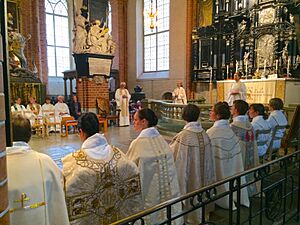
The Church of Sweden has three main types of ordained leaders: bishops, priests, and deacons. There are about 5,000 ordained clergy in total.
In the Church of Sweden, a person can be directly ordained as a priest without first being ordained as a deacon. All deacons in the Church of Sweden are "permanent deacons," meaning their main role is to serve others. Bishops, however, must first be ordained as priests before they can become bishops.
After the Reformation, the Swedish Church sometimes ordained people directly and sometimes in steps. Direct ordination became more common. Church leaders wear special clothes called vestments. For example, a stole is worn differently by bishops, priests, and deacons to show their role.
The Church of Sweden has full-time deacons who work in social welfare programs. While deacons have traditional roles in church services, their main work is often outside the church building, helping people in the community.
Dioceses and Bishops
The Church of Sweden is divided into thirteen dioceses (Swedish: stift). Each diocese has a bishop and a group of leaders called a cathedral chapter. The bishop is chosen by priests, deacons, and some church members in that diocese.
Each diocese is divided into smaller areas called "deaneries," led by a provost. The main minister of a cathedral is called a "cathedral dean" and is part of the cathedral chapter.
At the local level, a church area is called a parish (Swedish: församling). One or more parishes form a "pastorat," which has a head minister called a "kyrkoherde" (church shepherd).
Besides the 13 dioceses in Sweden, the Church of Sweden Abroad (Swedish: Svenska kyrkan i utlandet – SKUT) has over 40 parishes in other countries. SKUT has a special structure and is overseen by the Bishop of Visby.
| Diocese | Diocesan coat of arms | Seat | Cathedral | Founded | Current bishop | Bishop's coat of arms |
|---|---|---|---|---|---|---|
| Archdiocese of Uppsala | Uppsala | Uppsala Cathedral 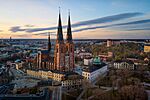 |
1123 | Martin Modéus (Archbishop)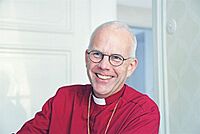 Karin Johannesson (Bishop) |
||
| Diocese of Skara | Skara | Skara Cathedral | 1014 | Åke Bonnier | ||
| Diocese of Lund | Lund | Lund Cathedral  |
1048 | Johan Tyrberg | ||
| Diocese of Linköping | Linköping | Linköping Cathedral 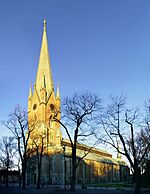 |
1100 | Marika Markovits | ||
| Diocese of Strängnäs | 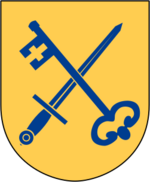 |
Strängnäs | Strängnäs Cathedral 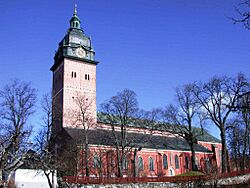 |
1129 | Johan Dalman | |
| Diocese of Växjö | 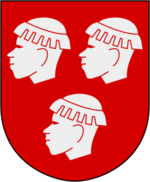 |
Växjö | Växjö Cathedral 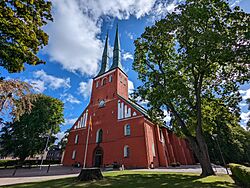 |
1165 | Fredrik Modéus | |
| Diocese of Västerås | 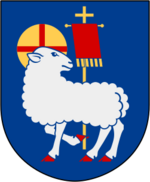 |
Västerås | Västerås Cathedral 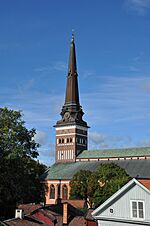 |
12th century | Mikael Mogren | |
| Diocese of Visby | 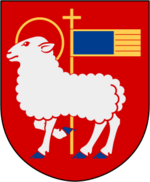 |
Visby | Visby Cathedral 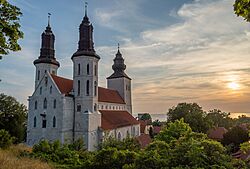 |
1572 | Erik Eckerdal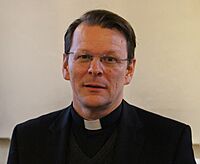 |
|
| Diocese of Karlstad | 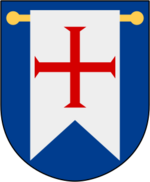 |
Karlstad | Karlstad Cathedral 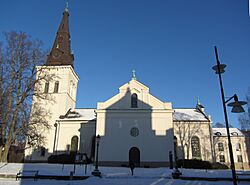 |
1581 | Sören Dalevi | |
| Diocese of Gothenburg | 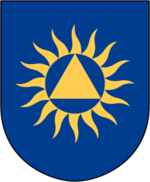 |
Gothenburg | Gothenburg Cathedral 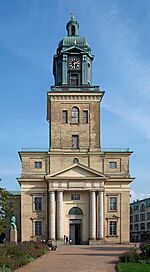 |
1620 | Susanne Rappmann  |
|
| Diocese of Härnösand |  |
Härnösand | Härnösand Cathedral 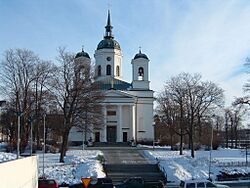 |
1647 | Eva Nordung Byström | |
| Diocese of Luleå |  |
Luleå | Luleå Cathedral 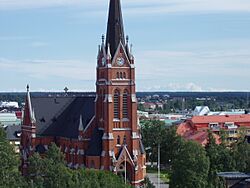 |
1904 | Åsa Nyström | |
| Diocese of Stockholm | 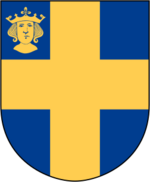 |
Stockholm | Stockholm Cathedral  |
1942 | Andreas Holmberg 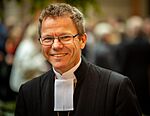 |
|
The dioceses of Uppsala, Strängnäs, Västerås, Skara, Linköping, and Växjö are the original seven Swedish dioceses from the Middle Ages. The others were created after the Swedish Reformation in the 1500s.
Monasteries and Convents
The Church of Sweden has several communities where people live together in a religious way, like monasteries and convents.
- The Sisters of the Holy Paraclete (Helgeandssystrarna) live in Alsike Convent.
- The Brothers of the Holy Cross (Heliga korsets brödraskap), who are Benedictine monks, live at the Östanbäck Monastery in Sala.
- The Sisters of St. Francis (Helige Franciskus systraskap), who are Franciscan nuns, live in Klaradals kloster in Sjövik.
- The Sisters of the Risen Saviour (Uppståndne frälsarens systraskap) live in Överselö klostergård.
- The Daughters of Mary (Mariadöttrarna av Den Evangeliska Mariavägen) are in Vallby.
- Linköpings kloster in Linköping was approved in 2006 and opened in 2014. It is a small convent focused on prayer and environmental issues.
Partner Churches Around the World
The Church of Sweden is a founding member of the Lutheran World Federation, which started in Lund, Sweden, in 1947.
Since 1994, the Church of Sweden has been part of the Porvoo Communion. This means it has a close relationship with Anglican churches in the British Isles and other Lutheran churches in the Nordic and Baltic countries. In 1995, it also formed a close partnership with the Philippine Independent Church. Since 2015, the Church of Sweden has been in full communion with the Episcopal Church in the United States.
In 2016, the Church of Sweden also formed a close partnership with the Old Catholic churches in the Union of Utrecht.
Relations with the Sámi People
In 2021, the Church of Sweden apologized for how it treated the Sámi people over many centuries. This included forcing them to become Christian and mistreating children in Sámi schools. The church also collected the remains of Sámi people for research that supported harmful ideas about race. The Church of Sweden called its actions against the Sámi "colonial" and "legitimized repression." Before apologizing, the church created a long document in 2019 that detailed its history of oppressing Sámi people and trying to erase their culture.
Images for kids
-
Preparing for the celebration of mass in Strängnäs Cathedral, Church of Sweden
See also
 In Spanish: Iglesia de Suecia para niños
In Spanish: Iglesia de Suecia para niños


